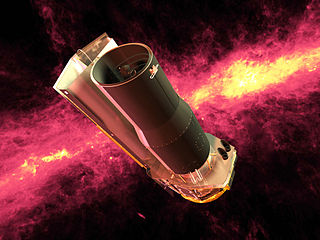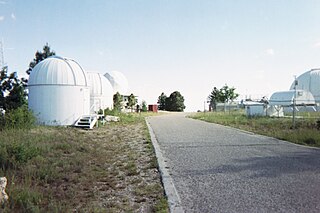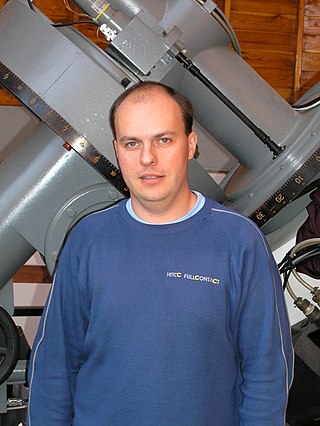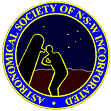Related Research Articles

The American Astronomical Society is an American society of professional astronomers and other interested individuals, headquartered in Washington, DC. The primary objective of the AAS is to promote the advancement of astronomy and closely related branches of science, while the secondary purpose includes enhancing astronomy education and providing a political voice for its members through lobbying and grassroots activities. Its current mission is to enhance and share humanity's scientific understanding of the universe as a diverse and inclusive astronomical community.

The Spitzer Space Telescope, formerly the Space Infrared Telescope Facility (SIRTF), is an infrared space telescope launched in 2003, that was deactivated when operations ended on 30 January 2020. Spitzer was the third space telescope dedicated to infrared astronomy, following IRAS (1983) and ISO (1995–1998). It was the first spacecraft to use an Earth-trailing orbit, later used by the Kepler planet-finder.

The Spacewatch Project is an astronomical survey that specializes in the study of minor planets, including various types of asteroids and comets at University of Arizona telescopes on Kitt Peak near Tucson, Arizona, in the United States. The Spacewatch Project has been active longer than any other similar currently active programs.

Catalina Sky Survey is an astronomical survey to discover comets and asteroids. It is conducted at the Steward Observatory's Catalina Station, located near Tucson, Arizona, in the United States.
Roy A. Tucker (1951 – 2021) was an American astronomer best known for the co-discovery of near-Earth asteroid 99942 Apophis (formerly known as 2004 MN4) along with David J. Tholen and Fabrizio Bernardi of the University of Hawaii. He was a prolific discoverer of minor planets, credited by the Minor Planet Center with the discovery of 702 numbered minor planets between 1996 and 2010. He also discovered two comets: 328P/LONEOS–Tucker and C/2004 Q1, a Jupiter-family and near-parabolic comet, respectively.

Gordon John Garradd is an Australian amateur astronomer and photographer from Loomberah, New South Wales. He has discovered numerous asteroids and comets, including the hyperbolic comet C/2009 P1, and four novae in the Large Magellanic Cloud. The asteroid and Mars-crosser, 5066 Garradd, was named in his honour.

Donald Edward Machholz was an American amateur astronomer who was credited with the discovery of 12 comets that bear his name.
Jeffrey S. Medkeff, usually known as Jeff Medkeff, was a prominent science writer and educator. He was also a designer of robotic telescopes, a minor philanthropist, and an advocate of personal and sexual freedom.

Mount Lemmon Observatory (MLO), also known as the Mount Lemmon Infrared Observatory, is an astronomical observatory located on Mount Lemmon in the Santa Catalina Mountains approximately 28 kilometers (17 mi) northeast of Tucson, Arizona (US). The site in the Coronado National Forest is used with special permission from the U.S. Forest Service by the University of Arizona's Steward Observatory, and contains a number of independently managed telescopes.
James Whitney Young is an American astronomer who worked in the field of asteroid research. After nearly 47 years with the Jet Propulsion Laboratory at their Table Mountain Facility, Young retired July 16, 2009.
Stephen J. Edberg is a scientist at the Jet Propulsion Laboratory. He is perhaps best known for creating collaborative efforts between amateur and professional astronomers. A professional astronomer since 1970, Edberg still considers himself to be an active amateur astronomer as well and is an active astronomical observer, photographer, and telescope maker. He presently serves as staff astronomer for the Solar System Exploration website posted by NASA Headquarters and staff scientist for Earth science communication and for Exoplanet Exploration communication.
John "Jack" Borden Newton is a Canadian astronomer, best known for his publications and images in amateur astrophotography.

The Space Science Institute (SSI) in Boulder, Colorado, is a nonprofit, public-benefit corporation formed in 1992. Its purpose is to create and maintain an environment where scientific research and education programs can flourish in an integrated fashion. SSI is among the four non-profit institutes in the US cited in a 2007 report by Nature, including Southwest Research Institute, Planetary Science Institute, and Eureka Scientific, which manage federal grants for non-tenure-track astronomers.

Kamil Hornoch is a Czech astronomer who discovered dozens of novae in nearby galaxies. The main belt asteroid 14124 Kamil is named in his honour.

Linda A. Morabito, also known as Linda Kelly, Linda Hyder, and Linda Morabito-Meyer, is the astronomer who discovered volcanic activity on Io, a moon of Jupiter. She made this finding on March 9, 1979, at NASA's Jet Propulsion Laboratory. At the time of her discovery, she was serving as Cognizant Engineer over the Optical Navigation Image Processing System (ONIPS) on the Voyager deep space mission Navigation Team. While performing image processing analysis of a Voyager 1 picture taken for spacecraft navigation, she detected a 270 kilometres (170 mi) tall cloud off the limb of Io. The cloud was of volcanic origin. This was the first time in history that active volcanism was detected off of Earth. Her discovery is considered by some planetary scientists as the largest discovery of the planetary exploration program that has come out of Jet Propulsion Laboratory. Morabito is currently an associate professor of astronomy at Victor Valley College. Linda Morabito Meyer is also the author of a memoir, Parallel Universes, a Memoir from the Edges of Space and Time.

The history of Mars observation is about the recorded history of observation of the planet Mars. Some of the early records of Mars' observation date back to the era of the ancient Egyptian astronomers in the 2nd millennium BCE. Chinese records about the motions of Mars appeared before the founding of the Zhou dynasty. Detailed observations of the position of Mars were made by Babylonian astronomers who developed arithmetic techniques to predict the future position of the planet. The ancient Greek philosophers and Hellenistic astronomers developed a geocentric model to explain the planet's motions. Measurements of Mars' angular diameter can be found in ancient Greek and Indian texts. In the 16th century, Nicolaus Copernicus proposed a heliocentric model for the Solar System in which the planets follow circular orbits about the Sun. This was revised by Johannes Kepler, yielding an elliptic orbit for Mars that more accurately fitted the observational data.

C/2007 Q3 , is an Oort cloud comet that was discovered by Donna Burton in 2007 at Siding Spring Observatory in New South Wales, Australia. Siding Spring came within 1.2 astronomical units of Earth and 2.25 AU of the Sun on October 7, 2009. The comet was visible with binoculars until January 2010.

The Astronomical Society of New South Wales (ASNSW) is an amateur astronomy club in the state of New South Wales, Australia, founded in 1954.

An astronomical body collided with Jupiter, the largest planet in the Solar System, on March 17, 2016. The object in question has not been confirmed by NASA to be an asteroid or comet, but may be so.
Robert E. Holmes Jr. is an American amateur astronomer and professional photographer.
References
- "Donald C. Parker, solar system researcher, planetary photographer". The Meade Instruments Corporation. 2005. Archived from the original on 2006-10-23. Retrieved 2007-08-18.
- "JPL Small-Body Database Browser: 5392 Parker (1986 AK)". Jet Propulsion Laboratory . Retrieved 2007-08-18.
- "Past Amateur Achievement winners". Astronomical Society of the Pacific . Retrieved 2007-08-18.